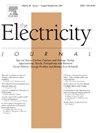绘制电力脆弱性指数:针对储能弹性解决方案的度量
IF 2.2
Q1 Social Sciences
引用次数: 0
摘要
不间断的电力供应对美国家庭的安全至关重要。更频繁和极端的紧急事件增加了全国各地的停电,对经历最频繁和最长停电的脆弱社区的影响不成比例,对电力损失最敏感,适应这些条件的能力最低。本研究设计了一个指标,即电力脆弱性指数(EVI),该指标捕捉了对电力中断的相对暴露度、敏感性和适应性,并通过2021年德克萨斯州冬季风暴Uri验证了该指标。虽然不是无处不在,但在EVI较高的邻近地区和风暴造成的停电率较高的地区之间观察到类似的趋势。EVI在整个美国大陆进行测绘,并作为一种可行的方法来量化人口对电力中断的脆弱性,以帮助政策制定者、倡导者和能源系统利益相关者有针对性地向最需要的社区部署弹性解决方案,如储能。本文章由计算机程序翻译,如有差异,请以英文原文为准。
Mapping the electric vulnerability index: A metric for targeting energy storage resilience solutions
Uninterrupted access to electricity is critical to the safety and security of American households. More frequent and extreme emergency events increase outages across the country, disproportionately impacting vulnerable communities that experience the most frequent and longest outages, are most sensitive to the loss of electric power, and have the least capacity to adapt to these conditions. This study devises a metric, the Electric Vulnerability Index (EVI), that captures relative exposure, sensitivity, and adaptability to electric outages, and validates this metric against the 2021 Winter Storm Uri in Texas. Though not ubiquitous, similar trends were observed between adjacent areas with higher EVI and those with higher outage rates from this storm. EVI is mapped across the continental United States and offered as a viable approach to quantify a population’s vulnerability to electric outages to aid policymakers, advocates, and energy system stakeholders in the targeted deployment of resilience solutions, such as energy storage, to communities most in need.
求助全文
通过发布文献求助,成功后即可免费获取论文全文。
去求助
来源期刊

Electricity Journal
Business, Management and Accounting-Business and International Management
CiteScore
5.80
自引率
0.00%
发文量
95
审稿时长
31 days
期刊介绍:
The Electricity Journal is the leading journal in electric power policy. The journal deals primarily with fuel diversity and the energy mix needed for optimal energy market performance, and therefore covers the full spectrum of energy, from coal, nuclear, natural gas and oil, to renewable energy sources including hydro, solar, geothermal and wind power. Recently, the journal has been publishing in emerging areas including energy storage, microgrid strategies, dynamic pricing, cyber security, climate change, cap and trade, distributed generation, net metering, transmission and generation market dynamics. The Electricity Journal aims to bring together the most thoughtful and influential thinkers globally from across industry, practitioners, government, policymakers and academia. The Editorial Advisory Board is comprised of electric industry thought leaders who have served as regulators, consultants, litigators, and market advocates. Their collective experience helps ensure that the most relevant and thought-provoking issues are presented to our readers, and helps navigate the emerging shape and design of the electricity/energy industry.
 求助内容:
求助内容: 应助结果提醒方式:
应助结果提醒方式:


